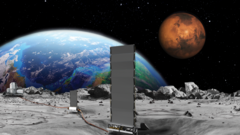NASA plans to expedite the construction of a nuclear reactor on the Moon by 2030, as reported by various U.S. media outlets. This initiative aligns with the United States’ goal to establish a permanent human presence on the lunar surface, but also reflects the increasing competition with nations such as China and Russia, which have expressed similar ambitions.
The urgency for this project was articulated by the acting NASA Administrator, who warned of the potential for rival nations to designate a "keep-out zone" on the Moon. Critics, however, question whether this timeline is achievable, especially in light of significant budget cuts that have recently affected NASA's operations. Some scientists fear that such plans are being driven more by geopolitical competition than by scientific progress.
As the global race to explore and exploit the Moon intensifies, with major players like the U.S., China, Russia, India, and Japan pursuing long-term lunar habitats, the stakes are high. U.S. Transportation Secretary Sean Duffy, who currently heads NASA, stated the urgent need for high-power energy generation to support a future lunar economy and national security interests. He called for commercial proposals for reactors capable of generating a minimum of 100 kilowatts of power—relatively modest compared to other energy sources.
Indeed, the idea of utilizing nuclear energy on the Moon is not novel. NASA previously awarded contracts to various companies to design potential reactor models. Additionally, China and Russia have unveiled plans to construct an automated nuclear power station on the Moon by 2035, emphasizing the importance of reliable energy generation in an environment characterized by prolonged sunlight followed by two weeks of darkness.
Experts suggest that nuclear power is essential for any sustainable lunar habitation. Dr. Sungwoo Lim, a senior lecturer in aerospace applications, highlights that solar arrays and batteries cannot meet the substantial energy demands for even a small lunar base. Similarly, Lionel Wilson, a professor of earth and planetary sciences, asserts that establishing the necessary infrastructure by 2030 is technically feasible, provided adequate funding is secured.
However, the initiative does present safety challenges, particularly concerning the launch of radioactive materials into space. Experts note that while such missions require stringent safety licensing, they are manageable.
Duffy's directive comes amid a backdrop of 24% budget cuts to NASA’s expenditure, a situation that casts doubt on the feasibility of these ambitious plans. Scientists have expressed concern that the agency's focus may be shifting from scientific exploration to a politically motivated race, reminiscent of the earlier Cold War era's space competition.
Dr. Simeon Barber, a planetary science specialist, shared reservations about the strategy, emphasizing that a narrowing focus on national interests might hinder broader scientific exploration. He also noted the potential implications of the Artemis accords—a gathering of seven nations which established principles for cooperation on the Moon—warning that creating a nuclear reactor could lead to claims of ownership over specific lunar regions.
Lastly, attaining a nuclear power source alone will not suffice for a sustainable presence on the Moon. Challenges exist in ensuring transportation logistics for crew and equipment. Duffy’s vision for nuclear energy on the lunar surface must address these complexities for the goal to become a reality, as evident in the ongoing trials and tribulations surrounding NASA's Artemis program, which aims to return humans to the Moon by 2027.


















